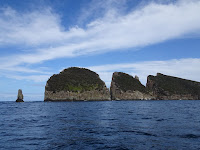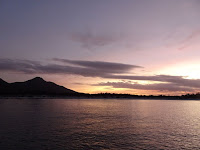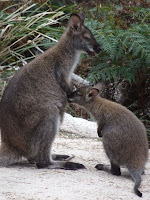[Kyle]We beat the first rays of sunshine to the harbor exit as we headed out. Even so, we were too late and had to dodge around an inbound cruise ship. It looks like Port Arthur is going to be a little more busy than when we saw it.
We sailed southeast to clear Tasman Island and then finally started making our way in earnest up Tasmania’s east coast. Tasman Island is an enormous 400-meter high mesa surrounded by near vertical cliffs. Impossibly, in the days before helicopters, they managed to erect a giant lighthouse right on top, which has clear views along the south and east coasts and all of the way up the Derwent to Hobart. Behind it, on the mainland, is Cape Pillar, which rises straight up to 913 meters above the water.







Amazing dolerite columns form the cliffs all along the miles of coast
The scenery around here is incredible. The cliffs are made up of Dolerite columns rising vertically to the tops like innumerable organ pipes. In between are areas of pink or orange granite, adding a splash of color. There are arches and caves galore in the places where the lower rock has given way and fallen into the sea.
The cliffs continued all of the way to Cape Huay (pronounced 'Hoy'), where we turned inland for our anchorage at Fortescue. Just before we got there, though, we were sailing close under the cliffs at a gap where two dolomite spires rose straight out of the sea. The smaller one is called the Totem Pole. It is a single dolerite column rising to 65m and only four meters wide. It is considered to be the most spectacular free-standing sea stack in the world.
Next to, and towering over the Totem Pole, is the slightly (but only slightly, in proportion) less slender 110m Candlestick. As we passed under it, I noticed a horizontal line connecting it over the Totem Pole to the mainland. My first thought was that it was a power line. We often see this as the electricity source for lighthouses, but Cape Huay doesn’t have a lighthouse. My next thought was that it was a zip line or possibly a line the Park Service uses to traverse the distance for some reason. Above it, we also saw a railing, which was likely the viewpoint at the terminus of a trail.
We watched for a bit and did see a guy at one end of the line who looked like he might be thinking about going across. We don’t know whether he was stopped by a stern sign or just the sight of the sky scraper-sized drop. After a couple of sightings, we didn’t see him anymore, so we continued around to the other side.
This was the side on which the trail ran. We could see several people up there, some milling around, some just sat enjoying the view. We also saw that there was definitely someone there who looked like he was climbing into a harness in preparation for a traverse. We milled around for a while, but nothing happened.
Doesn’t it figure, as soon as we gave up and started moving away, Maryanne spotted the guy pulling himself across, slung under the line, monkey-style. I hadn’t been able to turn the boat around and get back in time for her to get a good mid-chasm photo. It looked like others may be getting ready to head across to meet him, so we hung around some more, hoping to get the shot.
Then Maryanne, who was looking through the telephoto while I was steering, said, “There’s another guy, but he looks like he’s getting on TOP of the rope!”
What!? Time for the good binoculars.


Our life is definitely dull compared to some!
Yup, it WAS a guy standing on top of the line, tightrope-style (technically slack-lining). Then he started walking. He had no pole, so he was just using his arms for balance. He did have a safety line on, but it was not elaborate, only a tether attached to a belt and hooked to the rope behind him with a carabineer. I couldn’t imagine it would be comfortable putting all of the force of a fall on just the belt, or even being able to reach the line from below afterwards.
He walked to the other side, did a little 180° jump over the carabiner to face the other way, and then walked back. Then he did it again, and again. On the third pass, he spotted us, stopped, turned sideways and waved! He seemed completely comfortable up there as if he were strolling down a country lane. We definitely didn’t expect to see that today.
The weird thing was that no one else seemed to care. Of the twenty or so people at the viewpoint, I would have expected to see at least sixteen videoing the whole thing with smartphones. Instead, they were all sitting around looking bored, like they see this guy do it all of the time and just want him to finish so they can go home. Even the guy perched on the Candlestick side seemed more preoccupied with adjusting his gear than watching a guy walk on a rope 110m above a roiling sea (most likely it was a slack-line). Well, WE thought it was exciting!


And then came the dolphins!
Once were anchored in Fortescue Bay, we had a look at a trail map. There was a trail to Cape Huay right from the campground at the left end of the beach. By the occupancy of the campground, it looked pretty popular, too. Of course, the first thought I had was, “If that guy can do it, so can I!”
The next day, we headed out, ready for a real expedition. It wasn’t necessary. The trail is so well maintained that it’s practically paving stones all of the way to the Cape. We didn’t do it, but it occurred to us that it would be perfectly safe to walk at night with a headlamp. That would be good if you wanted to watch sunrise or sunset from the point or if you just wanted to spot some nocturnal critters.






Walking to Cape Huay (part of the 3 capes track)
Some amazing views as the trail takes us close to the edge
Good shoes weren’t necessary, neither were our hiking poles. I still wore my running shoes anyway. I had plans to fashion the laces into a safety harness if one wasn’t already there for public use.
Imagine my disappointment when we got to the end and found the line was gone. What were we going to do? I did a quick eyeball calculation and determined we would never be able to bridge the gap, even with both of our shoelaces, so we had to content ourselves with admiring the view from behind the railing.


Some of the campers were oblivious to their (Wallaby) visitors
Apart from the trail, the only other excitement we had was when we launched the dinghy into the surf to get back home. We timed it slightly wrong and I got swamped. Maryanne pushed me out into the bay so I could cross the surf line before it got me again. She never made it in the dinghy, so I had to bail out the water and then row to the boat ramp pier to pick her up.

























































